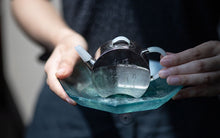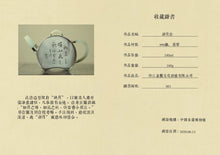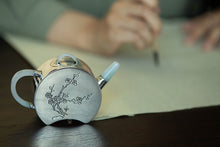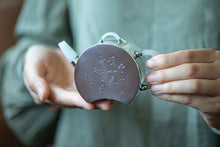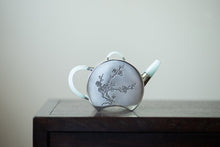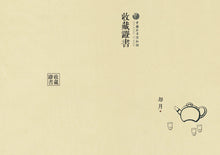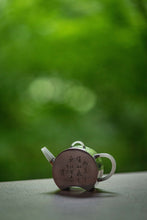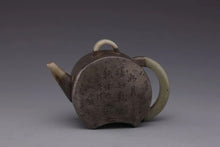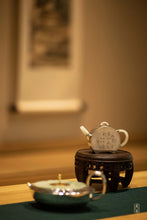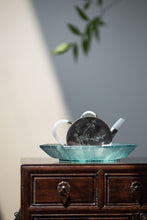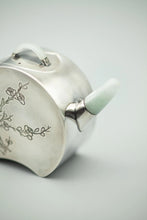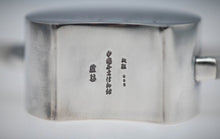
Limited Edition | Re-engraving of the literati teapot "Que Yue" in the mid-Qing Dynasty, the same in the collection of the China Tea Museum. Because of the lnstagram text limitation, I will write all the information about this teapot on my website and the lnstagram comment area. Welcome to read.
On the bank of West Lake in Hangzhou, there is China’s only national thematic museum with the theme of tea and tea culture—the China Tea Museum. In this museum, you can learn everything about Chinese tea culture. My friend discovered that Some people who come to the China Tea Expo must check in on the precious tea utensils in the collection. Among the tea utensils in the China Tea Expo collection, the mid-Qing Dynasty tin-coated sand pot named "Que Yue" is particularly popular. , There are always experienced tea enthusiasts lingering in front of its showcase, admiring its shape and tasting its charm. At this time, their biggest wish is: they can use this "Que Yue" teapot to drink a cup of tea. ! If you have ever made this wish, then this time my friend will help you realize your dream. As a gold and silverware making craftsmanship from the Lu family brand that has been inherited for a hundred years, Lu Yi will jointly launch with the China Tea Museum This collection of "Que Yue" pots is a reproduction version of only 365 pieces, each with a unique number and a collection certificate issued by the China Tea Museum. Slowly, the China Tea Museum chose the "Que Yue" pot for the re-engraving, hoping that the precious cultural relics can get out of the icy showcase, enter the lives of more people, and make the cultural relics come alive. At the same time, the "Que Yue" pot itself is also a typical representative of condensing the important historical and cultural connotations of traditional tea culture. It breaks through our full and round imagination of ordinary teapots. The biggest feature of the "Que Yue" pot is that the shape of the "Que Yue" pot is the image of missing the moon. The bottom of the consummation, the volley is fully closed, forming an image that the moon is about to be full, eh?
Doesn't the general design of utensils always choose the meaning of perfection? Why did the ancients design the "missing moon" style? Here we have to talk about the source of the "Kueyue" pot type. "Cheyue" is one of the "Mansheng Eighteen Styles". When it comes to Chinese teaware, you must mention the Yixing Zisha teapot, and when you mention the Zisha teapot, you must mention the "Mansheng Eighteen Styles." "Mansheng Eighteen Styles" is designed by Chen Hongshou, a painter and seal engraver of the Qing Dynasty who is one of the "Eight Schools of Xiling". The eighteen classic styles of purple clay pots are made by the brothers and sisters of Zisha artists Yang Pengnian and Yang Fengnian. Because of Chen Hongshou's character "Mansheng", it was named "Mansheng Eighteen Style" or "Mansheng Pot". In fact, the purple clay teapot was quite mature during the Qianlong period of the Qing Dynasty. However, the purple clay artisans at that time mostly traced the previous works and rarely innovated. However, the emergence of the eighteenth style of Mansheng became a glorious stroke in the history of the creation of purple clay teapots, and it has been established since then. It has become a benchmark in the history of Zisha, and it has become a classic of literati pots, and it is still unsurpassed. Therefore, the "Que Yue" pot of the China Tea Museum is a real pot designed by literati, taking the natural phenomenon of "missing the moon." It is necessary to be modest and prudent to live in the world, leaving room for everything. Moreover, Lu Yi reproduced the inscription on the front of the Juyue pot from the collection of the China Tea Museum: "Like the dawn of the moon, like the autumn of the air, imitating the small living method of snow and fragrance. "On the other side is a lightly carved old plum. The pharaoh has a profound artistic conception. The combination of the light and lofty artistic conception and the meaning of "Que Yue" can be described as a perfect match. Whether it's for yourself, making a pot of tea in peace, entertaining guests, sharing the spirit of ancient literati, or giving it as a gift to a confidant and friend. After all, the utensils on the tea table are in harmony with the owner's personality, and they are handy to use. For so long, there has been a tea club curious to re-engrave the purple clay teapot? Why look for Lu Yi who specializes in gold and silverware? This is to say the particularity of this "Que Yue" pot. This pot is made of purple sand in the pot and is covered with tin all over the body. The knob, handle and flow of the pot are all decorated with sapphire. This pot has a vivid name. , Called "three-inlaid pot". This can be regarded as a kind of repairing technique, because the original purple clay pot is precious but accidentally damaged, so the owner does not consider the cost of repairing it with gold and jade, in order to continue to use it, or to collect it completely, then such a literati pot made of multiple materials and multiple techniques. It requires the replica team to have both the background and the craftsmanship, as well as the ability to independently design. Of course, the final work must be professionally and rigorously checked, and Lu Yi takes root in Zhejiang. The Lu family’s gold and silver craftsmanship has been passed down for a hundred years, and it is Hangzhou’s intangible cultural heritage. In addition, Lu Yi has long been committed to the production of traditional Chinese handmade gold and silver tea wine vessels, integrating product development, design, and sales. Only by inheriting a century of handicraft and heritage, can he perfectly present the literary charm of the Mansheng pot. This time, "Que Yue" "The re-engraving of the pot uses a sterling silver body. Silver can soften the water quality, make the water taste better, and can also sterilize and disinfect. In ancient times, it was called "Ruosun Water". "Tea Shu" says: "Essence tea contains fragrance, and it is made by water, and tea is irrelevant if there is no water." Moreover, due to the scarcity of silver, it has always been monopolized by royal nobles and not only has its own economic value. It also contains artistic aesthetic value. Therefore, the silver kettle is not only a symbol of wealth, but also used as a hierarchical symbol of identity, status, and rights. In the era of fast consumption, if you use silver pots to boil water to make tea, you will also feel the sense of courtesy. Lu Yi will adhere to the all-hand forging manufacturing process, so it consumes a lot of labor time and energy. In addition, the pot shape is special and non-traditional, which requires special tools to complete. Both sides of the pot body are engraved to test the master's skill. In addition, the spout, the handle and the button are made of silver inlaid jade craftsmanship, which echoes the "three inlays" of the original pot. The silver inlaid jade process is more difficult, and the jade processing process is also very prone to damage, so this pot adds more difficulties. But it also reflects a different kind of exquisiteness. Many people have questions, and some have suffered a loss after stepping on thunder. Ancient artworks are good-looking and cultural, but will they be "unacceptable" when used for practical purposes? After all, our current lifestyle has undergone earth-shaking changes from ancient times. Don't think this is a small problem. Lu Yi attaches great importance to user experience. Therefore, when Lu Yi reproduces the "Chue Yue" pot, the designer needs to constantly adjust and test its practicability. From getting the actual object in the museum, to discussing the plan again and again, to computer modeling, printing model, sample testing... We finally determined the appropriate proportion version, and appropriately improved the original pot in the process of use. Reasonable. For example, the original size of the "Que Yue" tin-coated sand pot in the Qing Dynasty was 47mm*62mm*110mm, the widest point was 150mm, and the capacity was about 525ml, which was equivalent to the capacity of a bottle of ordinary Nongfu Spring. This is obviously too large for use on a modern tea table, and it is not easy to store and carry. So we reduced the value proportionally and changed it to 40mm*68mm*74mm, and the widest point was 116mm. The reduced "Chueyue" pot has a capacity of about 180ml. It is suitable whether it is for self-drinking, rubbing and playing, or entertaining three or five friends, drinking tea and chatting. In addition, because the "Que Yue" pot in the collection is made of tin-coated sand and inlaid with jade, its handle is too low, and it is too close to the body of the pot, and the hand cannot be carried through the handle. So designer Lu Yi modified the handle of the pot to make it safer and more convenient to make tea in a harmonious proportion. In fact, the reason why a re-engraved version can be called a "re-enacted version" is not just a mechanical copy, but it must meet certain conditions. That is, the re-engraved version must have important features different from the original, making it more than the original. winning. Lu Yi hopes to improve its practical functions without regrets while preserving the literati meaning of the Man Sheng pot "Que Yue". I solemnly reiterate that the silver re-engraved version of the mid-Qing Dynasty "Queyue" pot jointly launched by Lu Yi and China Tea Museum is for sale in limited quantities, each with a unique number, engraved with the logo of Lu Yi and China Tea Museum, with China Collection certificate issued by the Tea Museum. Among them, No. 001 has been donated by Lu Yi to the China Tea Museum.
在杭州西子湖畔,有中国唯一一座以茶和茶文化为主题的国家级专题博物馆——中国茶叶博物馆,在这座博物馆里,你可以了解到关于中国茶文化的一切,我的朋友发现,大部分来中国茶博的人,必打卡的,就是馆藏的珍贵茶器,而就在中国茶博馆藏的茶器精品中,有一把名为“却月 ”的清代中期的锡包砂壶尤为受欢迎,总有资深的茶器爱好者流连在它的展柜前,赏它的造型,品它的气韵,此时他们心中最大的愿望就是:能用这把“却月 ”茶壶喝一泡茶就好了!如果你也曾经许下过这个愿望,那这一次我的朋友将帮你圆梦,作为来源于至今传承已有百年历史的金银器制作手工艺卢氏家族品牌,盧藝将与中国茶叶博物馆联合推出此馆藏“却月 ”壶复刻版,仅限量365把,每把有唯一编号和中国茶博出具的收藏证书。手慢无,中国茶叶博物馆选择“却月”壶做复刻,是希望珍贵文物能走出冷冰冰的展柜,走进更多人的生活,让文物活起来。同时,“却月”壶本身也是凝聚传统茶文化中重要历史文化内涵的典型代表,突破我们对普通茶壶饱满圆润的想象,“却月”壶最大的特色就是造型取缺月为意象,在近似圆满的底部,凌空收足,形成一种月将满未满的形象,诶?一般设计器物不是都会选择圆圆满满之类的寓意吗?古人为何会设计“缺月”的样式呢?这里我们就不得不说“却月”壶型来源了。“却月”是“曼生十八式”之一,提起中国茶器,必提宜兴紫砂壶,提起紫砂壶,必提“曼生十八式”。“曼生十八式”是由身为“西泠八家”之一的清代书画家、篆刻家陈鸿寿亲自设计,紫砂艺人杨彭年、杨凤年兄妹亲手制作的十八种经典紫砂壶款式,因陈鸿寿字曼生,故名“曼生十八式”或“曼生壶”。其实紫砂壶发展到清代乾隆年间,已经相当成熟,然而当时的紫砂匠人多描摹前作,少有创新,但曼生十八式的出现,成为紫砂壶创作史上辉煌的一笔,并自此树立了一个紫砂史上的标杆,成为文人壶的经典之作,至今无出其右,所以,中国茶叶博物馆的“却月”壶是实实在在的由文人设计的壶,取自然现象“缺月”以寓为人处世需谦虚谨慎,凡事留有余地,并且,盧藝复刻此中国茶叶博物馆馆藏却月壶壶身正面镌铭:“如月之曙,如气之秋,仿雪香小居法。”另一面浅刻一枝老梅。手法老到,意境深远。清淡高远的意境与“却月”寓意的结合,可谓珠联璧合。无论是送给自己,安静自处时泡一壶清茶,还是招待宾客,共享古代文人精神,又或是作为礼物送给知己友人,都是再好不过。毕竟茶席上的器物,与主人性格脾气相投,用起来才是得心应手。那么久有茶友会好奇复刻紫砂壶?为什么要找专业做金银器的盧藝?这就要说这把“却月 ”壶的特殊性了,此壶为壶内紫砂胎,并通体包锡,壶钮、壶把及壶流均饰以青玉,这种壶有一个形象的名字,叫做“三镶壶”。这算是一种修复工艺,因为原紫砂壶珍贵,但意外破损,于是主人不计工本以金玉修缮,以求继续使用,或完整收藏,那这样由多种材质,多种工艺共同完成的文人壶,就要求复刻团队既有底蕴,也了解工艺,同时还要具备独立设计的能力。当然,最后的作品完成也要有专业严谨的把关,而盧藝生根浙江,卢氏家族金银器制作手工艺传承已有百年历史,为杭州非物质文化遗产。并且盧藝长期致力于中国传统手工金银茶酒器制作,集系列产品开发、设计、销售为一体,传承百年的手工艺与底蕴积淀,才能完美呈现曼生壶的文人气韵,此次“Que Yue ”壶的复刻,采用纯银壶身。银可以软化水质,使水口感更好,还能杀菌消毒。古称“若绢水”。《茶疏》有云:“精茗蕴香,借水而发,无水不可与论茶也。”而且,由于银的稀缺性,历来被皇家贵族所垄断,不仅具有其本身的经济价值,更蕴含艺术上的审美价值,所以,银壶不仅象征财富,更被用来作为身份、地位、权利的等级标志。当下快消费的时代,若用银壶煮水泡茶待客,同样也会让客人感受到备受礼遇之感。盧藝将坚持一直以来的全手工锻打制造工艺,所以它消耗的人工时间与精力都是极大的,加之此壶形制特别,非传统器造型,需用特制的工具才能完成。壶身两面均采用錾刻工艺,考验师傅手上功夫。另外,壶嘴、壶把、壶钮采用银镶玉工艺,与原壶的“三镶”呼应。银镶玉工艺较有难度,玉的加工过程还极易出现破损的问题,所以为此壶增加了更多的不易。但也体现出别样的精致。很多人有疑问,也有踩过雷吃过亏的,古代艺术品好看有文化,但拿来实用会不会“水土不服”?毕竟我们现在的生活方式与古代有着翻天覆地的变化。千万不要觉得这是个小问题,使用体验是盧藝非常重视的问题,所以盧藝在复刻“却月”壶时,设计师需不断调整和测试它的实用性。从博物馆上手实物,到一次次商讨方案,再到计算机建模,打印模型,样品测试......我们终于确定了合适的比例版本,并在适当改进了原壶在使用过程中的不合理之处。比如,清代“Que Yue ”锡包砂壶原壶身大小为47mm*62mm*110mm,最宽处为150mm,容量为525毫升左右,相当于一瓶普通农夫山泉的容量。这对现代茶席上的使用来说,显然就太大了,而且也不便于收纳携带。于是我们等比例缩小了数值,将其改为40mm*68mm*74mm,最宽处为116mm。缩小后的“却月”壶容量为180毫升左右,无论是自斟自饮,摩挲把玩,还是招待三五好友,饮茶谈天,都合适不过。另外,因为馆藏“Que Yue ”壶是经过锡包砂和镶玉的,导致它的壶把处过于低,并且贴壶身太近,手无法穿过壶把提拿。于是盧藝设计师将壶把处做了改动,让它在和谐的比例中,能更安全更方便的泡茶。其实,复刻版之所以能被称为“复刻版”,不是生搬硬套,而是必需要满足一定的条件,那就是复刻版要有异于原版的重要特色,使其相对于原版更为优胜。盧藝希望在最大保留曼生壶“却月”文人意蕴的前提下,提升它的实用功能,不留遗憾。再郑重重申一遍,此次盧藝与中国茶叶博物馆联合推出的银质复刻版清中期“却月”壶为限量发售,每把有唯一编号,刻有盧藝与中国茶叶博物馆标识,有中国茶叶博物馆颁发的收藏证书。其中001号已由盧藝捐赠给中国茶叶博物馆。












